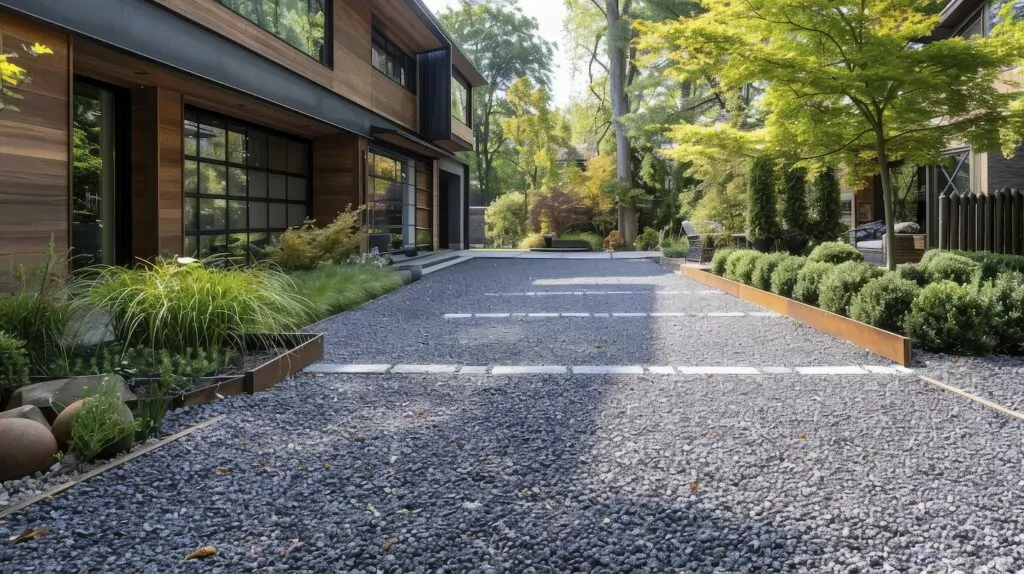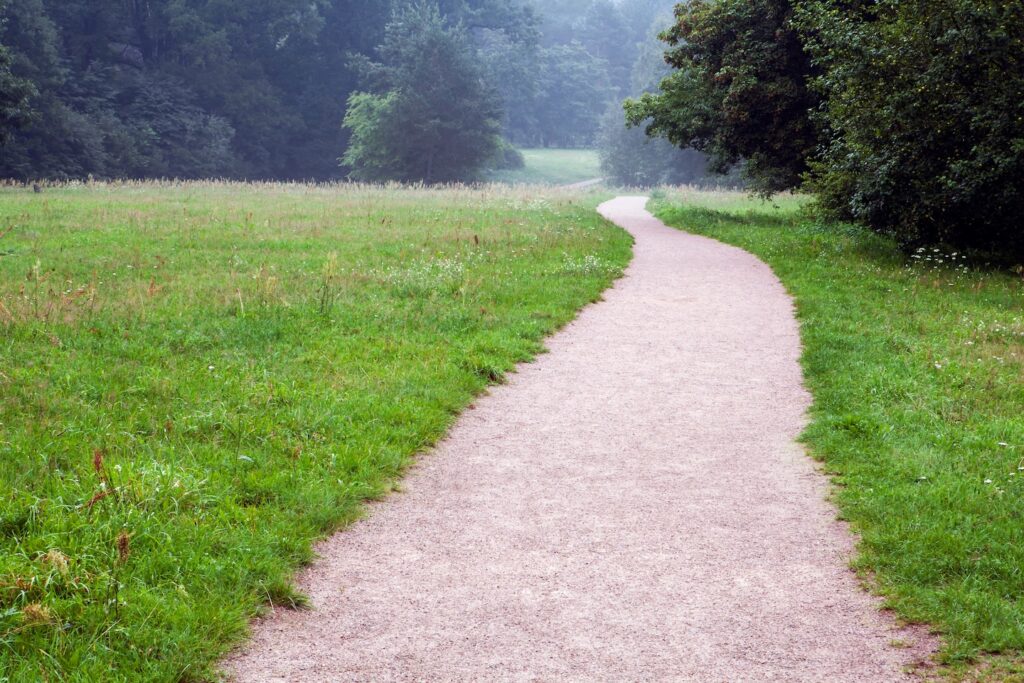Are you looking to add a charming and functional element to your outdoor space? A gravel path might be just what you need. Whether you’re aiming for a rustic garden walkway or a modern driveway, gravel paths offer versatility, low maintenance, and aesthetic appeal. Read on to discover everything you need to know about creating your own gravel path, from planning and materials to construction and maintenance.
Introduction
Gravel paths are becoming more popular with homeowners and gardeners for good reasons. They give a natural, rustic look that fits well with different garden styles, adding to the beauty of outdoor spaces. Gravel paths also drain water well and handle lots of foot traffic, making them a practical choice for daily use.
Another advantage of gravel paths is their low maintenance. Compared to other materials, gravel requires minimal upkeep, saving time and effort for homeowners. The versatility of gravel paths is also noteworthy, as they can be used for garden walkways, driveways, and even as an alternative to traditional lawns. With their combination of beauty, practicality, and ease of care, gravel paths offer an attractive alternative for enhancing any landscape design.
Planning Your Gravel Path

Creating a gravel path is a great way to enhance your outdoor space, but thoughtful planning and design are key to making it both functional and appealing.
Choosing the Right Location
Before you start digging, it’s important to carefully plan where your gravel path will go. Think about its purpose—will it be a main walkway, a garden path, or a driveway? The use will help you decide whether to go with crushed rock for a sturdy path or pea gravel for a softer look.
Next, check the terrain where you’ll install the path. Is it flat or sloped? A sloped path will need extra drainage to prevent erosion and keep it stable. You might also use flat stones on slopes for better footing.
Make sure your new path fits in with your garden or yard. It should match the style of your landscape and improve the overall design. Lastly, think about how easy it will be to use. Whether it’s a gravel walkway with stepping stones or a crushed limestone pathway, make sure it connects important areas and is easy to navigate.
Designing Your Gravel Walkway
The design of your path can greatly affect the overall look of your outdoor space. When planning, there are a few key design elements to keep in mind. The shape of your path sets the tone for your landscape. Straight paths give a formal, structured feel, which works well for modern or traditional styles. Curved paths create a more relaxed, natural vibe, perfect for cottage or woodland gardens. If you’re adding gravel and stones, you can also experiment with different patterns.
The width of your path matters for both looks and function. For easy walking, aim for at least 3 feet wide for secondary paths and 4 feet for main walkways. This makes sure people can walk side by side or pass each other easily. Adding edging with materials like bricks or metal gives the path a clean, finished look.
Lastly, think about adding focal points along your path to make it more interesting and create a sense of journey. Whether it’s a gravel path with stepping stones or flat rocks as highlights, features like arbors or decorative items can really enhance the overall feel of your gravel pathway.
Materials Needed for Your Gravel Path

Selecting Gravel Types
When selecting the best gravel for walkways, consider the size, color, and texture that best complements your landscape design.
- Pea gravel pathway: Small, rounded stones ideal for a softer look and feel underfoot.
- Crushed stone path: Angular pieces that lock together, creating a more stable surface.
- River rock path: Smooth, rounded stones for a natural, water-worn appearance, perfect for paths.
- Crushed limestone: Offers a light color and compacts well for a firm surface, making it great for walkways.
Stepping Stones and Other Additions
To enhance the functionality and appearance of your gravel path, consider incorporating:
- Gravel and stepping stone walkway: Large, flat stones placed at intervals for easier walking.
- Pavers: Concrete or natural stone pavers can create a more structured look when combined with gravel.
- Decorative elements: Add interest with larger rocks, plants, or lighting along the path edges.
How to Build a Gravel Path
Follow these instructions to create your gravel pathway:
1. Mark the Path

Use stakes and string to outline the path’s shape and dimensions. Whether you’re planning a gravel and stepping stone path or a simple gravel pathway, this is the first step. You can also mark the ground along the string line with spray paint or flour to give a clear outline of where to dig.
2. Excavate the Area

Dig out the path area to a depth of 4 to 6 inches. For better drainage, create a slight crown in the center of the path so water runs off the sides. This is especially important for crushed rock pathways to guarantee long-term stability.
3. Install Edging

Place your chosen edging material along the sides of the path to keep the gravel contained. Secure the edging firmly in place to prevent gravel from spilling out over time. Edging is particularly useful for keeping a gravel stepping stone path neat and tidy.
4. Lay the Base

Line the excavated area with landscape fabric to help prevent weed growth. Then, add a 2-3 inch layer of coarse gravel or crushed stone as the base. Compact the base layer using a plate compactor or hand tamper to create a solid foundation.
5. Add Gravel

Spread a 2-3 inch layer of your chosen gravel over the base. Whether you’re using pea gravel or crushed stone, use a rake to distribute the gravel evenly across the path. Gently compact the gravel to create a stable walking surface.
6. Incorporate Stepping Stones (Optional)

If you’re adding stepping stones, place them at regular intervals along the path to create a gravel path with stepping stones. Make sure the stones are level with the gravel surface to allow for easy walking and an even look.
Maintenance of Your Gravel Path

Maintaining your gravel path is key to keeping it looking fresh and functional. By following a few simple steps, you can prevent weeds and make sure your path stays clean and well-maintained over time.
Keeping Your Path Clean
To keep your gravel path clean and looking its best, regular maintenance is essential. Rake the surface to redistribute the gravel and maintain an even, smooth appearance. Over time, you may need to add fresh gravel or replace worn sections to keep your crushed gravel paths in top shape.
Preventing Weeds
Weeds can quickly take over a gravel path if not managed properly. To prevent this, regularly pull any stray weeds that appear and consider applying a natural or chemical weed killer to stop them from returning.
Creative Ideas for Gravel Paths

Gravel paths and driveways offer endless possibilities when it comes to design and functionality. Whether you’re creating a sturdy driveway or a decorative walkway, the choices you make can transform the look and feel of your outdoor space.
Modern Gravel Driveways vs. Walkways
Gravel driveways and walkways both use gravel, but their designs and materials are often different. Driveways require a thicker layer of larger, more durable stones to support the weight of vehicles, while walkways use smaller, finer gravel for a comfortable walking surface. Driveways work best with compacted, angular gravel that stays in place, while walkways can use softer pea gravel or a mix of sizes for a decorative look. Each has its own purpose, but with careful design, both can improve the overall look of your landscape.
Unique Designs
Unleash your creativity by mixing various sizes or colors of gravel to craft a one-of-a-kind gravel and stone walkway. You can also define edges or highlight focal points using contrasting colors of gravel, creating a visually stunning landscape.
DIY Tips and Tricks

Building a Rock Walkway
Building a rock walkway creates a natural look by mixing larger rocks with gravel for a textured, rustic appearance. You can use flat rocks as stepping stones within the gravel path, making it both practical and attractive. To add to the natural feel, consider arranging different sizes of river rocks to create a dry creek bed effect, giving your walkway a charming, nature-inspired touch.
Easy DIY Gravel Path Projects
Gravel path projects are an easy way to improve your lawn. You can start by making a short garden path with gravel and repurposed materials like old bricks or logs for a unique, eco-friendly look. Another simple idea is to create a gravel patio area with clear edges and comfortable seating. Using gravel as low-maintenance ground cover in tricky areas of your yard can also help solve landscaping problems while adding visual appeal.
Conclusion
Building a gravel pathway is a fun DIY project that can spruce up any lawn or garden. Don’t hesitate to mix and match materials, shapes, and colors to make your gravel path stand out. So grab your tools, let your imagination run wild, and enjoy turning your yard into a cozy retreat!We’d love to hear about your gravel path projects; share your experiences or ask questions in the comments below. And if you need help with any part of your landscaping project, don’t hesitate to hire a Tasker for your yard work and landscaping needs.














